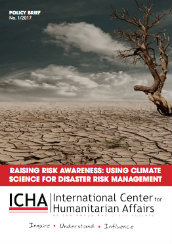Raising risk awareness: using climate science for disaster risk management
 This policy brief concludes that, from the climate science perspective, results show the 2016-17 drought is less severe than the 2010-11 drought in Lamu, while in Marsabit they are comparable. In general, the return time of the event over the regions analysed was low, meaning that this kind of drought is a relatively common event. It is important to note however that the 2016-17 drought is still ongoing. Kenya Meteorological Department is currently forecasting the potential for depressed rains in many of the drought effected areas of Kenya. If the 2017 long rains are ultimately depressed and the drought continues, the findings of this study will need to be updated. The brief offers lessons learned and recommendations regarding climate change information gathering, management and dissemination. It concludes that climate science can be utilized to inform risk reduction and adaptation strategies and approaches.
This policy brief concludes that, from the climate science perspective, results show the 2016-17 drought is less severe than the 2010-11 drought in Lamu, while in Marsabit they are comparable. In general, the return time of the event over the regions analysed was low, meaning that this kind of drought is a relatively common event. It is important to note however that the 2016-17 drought is still ongoing. Kenya Meteorological Department is currently forecasting the potential for depressed rains in many of the drought effected areas of Kenya. If the 2017 long rains are ultimately depressed and the drought continues, the findings of this study will need to be updated. The brief offers lessons learned and recommendations regarding climate change information gathering, management and dissemination. It concludes that climate science can be utilized to inform risk reduction and adaptation strategies and approaches.
